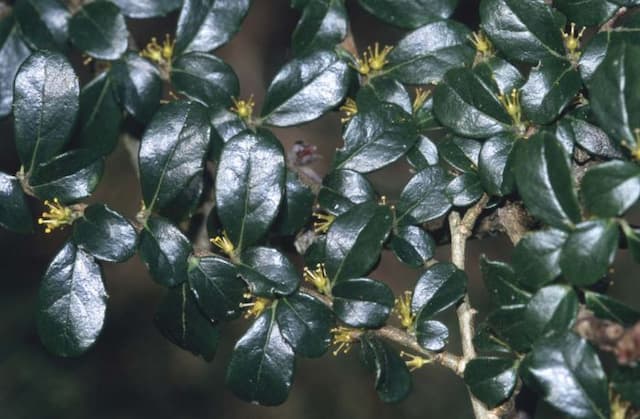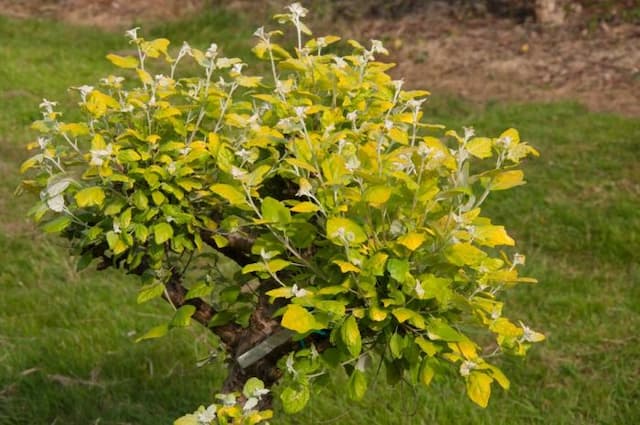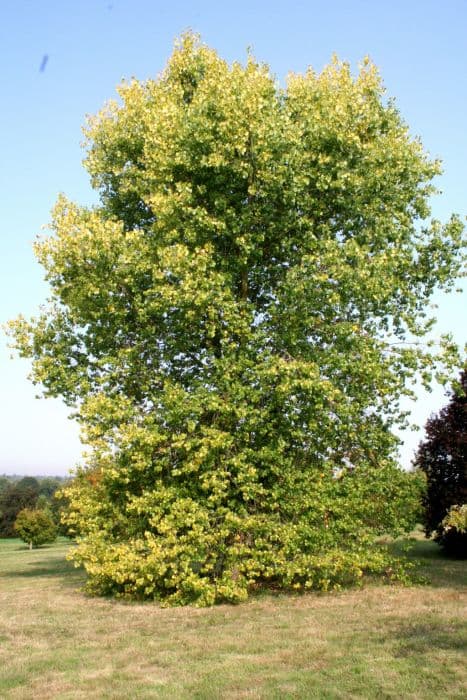Yezo Alpina Willow Salix nakamurana var. yezoalpina

ABOUT
The plant in question, commonly known as the Yezo alpine willow, is characterized by its flexible branches which often bear a profusion of narrow leaves. These leaves tend to be green with a slightly blueish tint, perhaps due to a fine layer of hairs that can give them a silvery appearance. The shape of the leaves is generally elongated, often with a pointed tip. During the blooming period, the Yezo alpine willow produces flowers which are structured in what are called catkins; these are slim, cylindrical flower clusters. Each catkin is composed of numerous small flowers without significant petals, which is typical for willow species. The flowers can vary from green to yellowish tones and are often accompanied by fluffy white seeds that can be seen floating in the air once mature. The bark of this plant is another distinctive feature, typically presenting a rough texture and a color palette that ranges from grey to brown shades. The overall aesthetic of the Yezo alpine willow is one that is quite rugged and robust, often exuding a wild beauty that resonates well with the alpine environments where it is commonly found.
About this plant
 Names
NamesFamily
Salicaceae
Synonyms
Yezo Alpine Willow
Common names
Salix nakamurana var. yezoalpina.
 Toxicity
ToxicityTo humans
There is limited specific information available about the toxicity of Salix nakamurana var. yezoalpina, more commonly known as "dwarf willow," to humans. Generally, willow species contain salicin, which is a precursor to aspirin and can be toxic in large quantities. Ingesting parts of the dwarf willow plant could potentially lead to symptoms similar to aspirin overdose, such as stomach pain, nausea, vomiting, and in severe cases, kidney failure, seizures, or even coma. The actual risk and severity of symptoms would likely depend on the quantity ingested and the individual's sensitivity.
To pets
As with their potential effects on humans, the toxicity of Salix nakamurana var. yezoalpina, commonly referred to as "dwarf willow," to pets is not well-documented. Generally, willow species contain salicin, which can be harmful in high doses. Symptoms of willow poisoning in pets might include gastrointestinal upset, such as vomiting and diarrhea, and more serious side effects could be similar to those of salicylate (aspirin) toxicity, leading to gastric ulceration, metabolic acidosis, kidney dysfunction, or neurological problems. The severity of symptoms would be dependent on the amount consumed and the specific sensitivity of the pet.
 Characteristics
CharacteristicsLife cycle
Perennials
Foliage type
Deciduous
Color of leaves
Green
Height
6 5 [2m]
Spread
6 5 [2m]
Plant type
Shrub
Native area
Japan
Benefits
 General Benefits
General Benefits- Erosion Control: Salix nakamurana var. yezoalpina, commonly known as Yezo Willow, has an extensive root system that can stabilize soil and prevent erosion in vulnerable areas.
- Habitat Creation: Yezo Willow provides a natural habitat for various species of wildlife, offering shelter and nesting sites for birds and small mammals.
- Windbreak: The dense foliage and robust growth of Yezo Willow can serve as a windbreak, protecting other plants and reducing wind erosion of soil.
- Ornamental Value: Yezo Willow is appreciated for its aesthetic appeal in garden and landscape design, contributing to scenic beauty with its slender branches and lush leaves.
- Biodiversity Support: By providing food and habitat, the Yezo Willow contributes to the overall biodiversity of an area, supporting a range of insect and bird species.
- Riparian Buffers: Along stream banks and waterways, Yezo Willow can act as a riparian buffer, filtering runoff and improving water quality by trapping sediment and pollutants.
- Noise Reduction: When planted in dense groups, Yezo Willow can help absorb sound, acting as a natural barrier to noise pollution.
 Medical Properties
Medical Properties- This plant is not used for medical purposes.
 Air-purifying Qualities
Air-purifying QualitiesThis plant is not specifically known for air purifying qualities.
 Other Uses
Other Uses- Art and Craft Material: The flexible branches of the Salix nakamurana var. yezoalpina, commonly known as Japanese Willow, can be used in basket weaving and other traditional crafts.
- Landscape Design: Due to its attractive foliage and growth habit, Japanese Willow can be integrated into garden designs for visual interest, especially in rock gardens or as part of water features.
- Erosion Control: The robust and fast-growing root system of Japanese Willow is effective in stabilizing soil and preventing erosion on riverbanks and in mountainous regions.
- Windbreaks: The species is used to create windbreaks to protect more sensitive plants or reduce wind damage to agricultural lands.
- Support for Climbing Plants: The sturdy branches of Japanese Willow can serve as natural supports for climbing plants and vines within a mixed planting scheme.
- Soil Improvement: As the leaves fall and decompose, they enrich the soil with organic matter, thereby improving soil quality over time.
- Wildlife Habitat: The dense foliage provides shelter and nesting sites for birds and other wildlife while its catkins offer a source of food.
- Education and Research: Botanists and horticulture students may use the species for study purposes, learning about willow-specific characteristics and adaptations.
- Livestock Fodder: In some rural areas, the leaves of Japanese Willow may be used as an emergency fodder for livestock, although this is not common practice.
- Photography and Painting Subject: With its picturesque appearance, the plant is often used as a subject for photography and landscape painting, particularly in its natural habitat.
Interesting Facts
 Feng Shui
Feng ShuiThe Dwarf Arctic Willow is not used in Feng Shui practice.
 Zodiac Sign Compitability
Zodiac Sign CompitabilityThe Dwarf Arctic Willow is not used in astrology practice.
 Plant Symbolism
Plant Symbolism- Flexibility and Resilience: Salix nakamurana var. yezoalpina, commonly known as the Yezo Alpina Willow, demonstrates great flexibility and resilience in harsh climates, symbolizing the ability to adapt and thrive in challenging conditions.
- Healing: Willows have been associated with healing due to the salicylic acid found in their bark, which is a compound similar to the active ingredient in aspirin. This symbolizes comfort and recovery from pain or illness.
- Growth and Renewal: The Yezo Alpina Willow's capability to sprout from cut branches or damaged parts represents growth and renewal, and the idea that life can continue and flourish even after difficulty.
- Feminine and Moon Energy: In various cultures, willow trees are often linked with feminine energy and the moon due to their connection with water and the intuitive aspect of nature, reflecting inner wisdom and deep emotions.
- Sorrow and Mourning: Historically, willow trees have been a symbol of sorrow and mourning, likely because of their weeping form, offering an acknowledgment of grief and a place for reflection.
- Protection: Some beliefs hold that willows have protective qualities, sheltering those near them with their vast canopies and deep root systems, thus providing physical and spiritual sanctuary.
 Water
WaterJapanese Willow or Yezo Alpina requires consistent moisture but should not be waterlogged. It thrives best when given deep watering every week, especially during the growing season or at least whenever the top inch of the soil feels dry to the touch. Aim to provide between 1 to 2 gallons of water for each watering session to ensure the soil is thoroughly moistened. During the hot summer months, you may need to increase the frequency to twice a week to prevent the soil from drying out completely. In winter, you can reduce watering as the plant's water requirements decrease.
 Light
LightThe Japanese Willow prefers full sun to partial shade, with a preference for sun-drenched locations that receive several hours of direct sunlight each day. It will perform best when placed in a spot where it can enjoy morning sunlight followed by light afternoon shade, which helps protect it from the intense heat of the day.
 Temperature
TemperatureJapanese Willow is hardy and can withstand cold temperatures down to about -20 to -30 degrees Fahrenheit, making it suitable for cooler climates. The ideal growing temperature range for this plant is between 50 to 75 degrees Fahrenheit. While it can tolerate a variety of temperatures, extreme heat above 95 degrees Fahrenheit may stress the plant and require additional care.
 Pruning
PruningPruning the Japanese Willow promotes a strong structure, removes dead or damaged branches, and encourages fresh growth. It is best to prune in late winter or early spring before new leaves emerge. Thin out crowded branches and shape the tree as needed, focusing on maintaining its natural form. Pruning should occur at least once a year or more frequently to address any wayward growth.
 Cleaning
CleaningAs needed
 Soil
SoilThe Creeping Willow prefers evenly moist, well-draining soil with a mixture of loam, peat, and sand to ensure proper drainage. A slightly acidic to neutral pH of 5.5-7 is best for this plant.
 Repotting
RepottingCreeping Willow should be repotted every 2 to 3 years to refresh the soil and accommodate root growth, preferably in the spring.
 Humidity & Misting
Humidity & MistingCreeping Willow thrives in moderate to high humidity levels, mimicking its natural alpine and riverside habitats.
 Suitable locations
Suitable locationsIndoor
Provide bright light, moist soil, and maintain high humidity for Creeping Willow.
Outdoor
Plant in sun to partial shade, keep soil moist, and protect from strong winds for Creeping Willow.
Hardiness zone
4-9 USDA
 Life cycle
Life cycleSalix nakamurana var. yezoalpina, more commonly known as Yezo-alpine willow, begins its life cycle as a seed, typically dispersed by wind or water. After landing in a suitable moist and cool alpine habitat, the seed germinates in spring, establishing a root system and sending up shoots. As a fast-growing willow, it quickly develops into a small, hardy shrub with multiple stems and leaves, reaching maturity in just a few years. During its reproductive phase, Yezo-alpine willow produces flowers, known as catkins, which are pollinated by insects. After pollination, seeds are produced and dispersed, continuing the reproductive cycle. The plant has a perennial life cycle, with individual shrubs capable of surviving for multiple years in the harsh alpine environment before eventually dying, either from environmental stress or senescence.
 Propogation
PropogationPropogation time
Spring
Propogation: For the plant known as Sakhalin Willow, the most popular method of propagation is by using cuttings. This process typically takes place during the plant's dormancy period, which usually falls in the late winter or early spring. The process involves taking cuttings of new growth, approximately 6 to 8 inches (15 to 20 centimeters) in length, and planting them in a moist potting mix or directly in the ground where they are to grow. The cuttings should be placed such that at least two sets of leaf nodes are buried, which will encourage root growth. It is important to keep the soil consistently moist until the cutting has established a strong root system, after which it can be treated as a mature plant.









